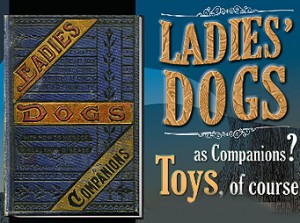Ladies’ Dogs as Companions? Toys, of course!
266 – September, 2016
By Debra Lampert-Rudman
 If I were creating a list of dog breeds one might consider to be “ladies” dogs – or more popular with women, great with kids and families – surprisingly quite a few breeds on my list today would be the same ones appearing in Dr. William Gordon-Stables’ 1879 classic Ladies’ Dogs as Companions: A Chatty Pleasant Book with Many Stories Humorous & Pathetic Painted From Life.
If I were creating a list of dog breeds one might consider to be “ladies” dogs – or more popular with women, great with kids and families – surprisingly quite a few breeds on my list today would be the same ones appearing in Dr. William Gordon-Stables’ 1879 classic Ladies’ Dogs as Companions: A Chatty Pleasant Book with Many Stories Humorous & Pathetic Painted From Life.
I recently inherited a very large number of very old breed books, and this book, with its deep blue leather cover brightened with gold and red lettering, caught my eye as soon as I opened its box. It was in such great condition that I was surprised to find it was a first edition published in London in 1879. I learned that its author, Dr. William Gordon-Stables, was born in Scotland, served in the Royal Navy, and was possibly best known for his “boys’ adventure fiction” in the style of Jules Verne.
Carefully paging through the book, of the 18 dog breeds Dr. Gor- don-Stables described, seven were Toy breeds: The Blenheim Spaniel (today’s red and white English Toy Spaniel), The Pomeranian, The Maltese Terrier, The Poodle, The Yorkshire, alias Scotch Terrier, The King Charles Spaniel (today’s Black and Tan English Toy Spaniel), and The Pug Dog. The Newfoundland, Collie, Skye Terrier, St. Bernard, Dachshund and English and Italian Greyhounds rounded out the Doctor’s varied list.
Photography was only invented 40 years prior to the book’s publi- cation and still wasn’t that widely used. The photographs were quite clear, however the way the publisher combined various breeds to- gether on one page was rather odd and out of proportion.
Dr. Gordon-Stables apparently lived with quite a few of the breeds he wrote about because his anecdotes and stories following his general descriptions of their conformation and care were rather personal and heartrending.
“My chapters on the common-sense treatment of dogs, both in health and dis- ease, are, I humbly hope, calculated to do good. I am one of those who believe that if dogs are properly fed, housed, and cared for, they will never fall sick. The old-fashioned proverb, ‘Prevention is far better than cure,’ holds wonderfully true as regards the canine race.”
Click here to read the complete article266 – September, 2016
Short URL: https://caninechronicle.com/?p=112277
Comments are closed











